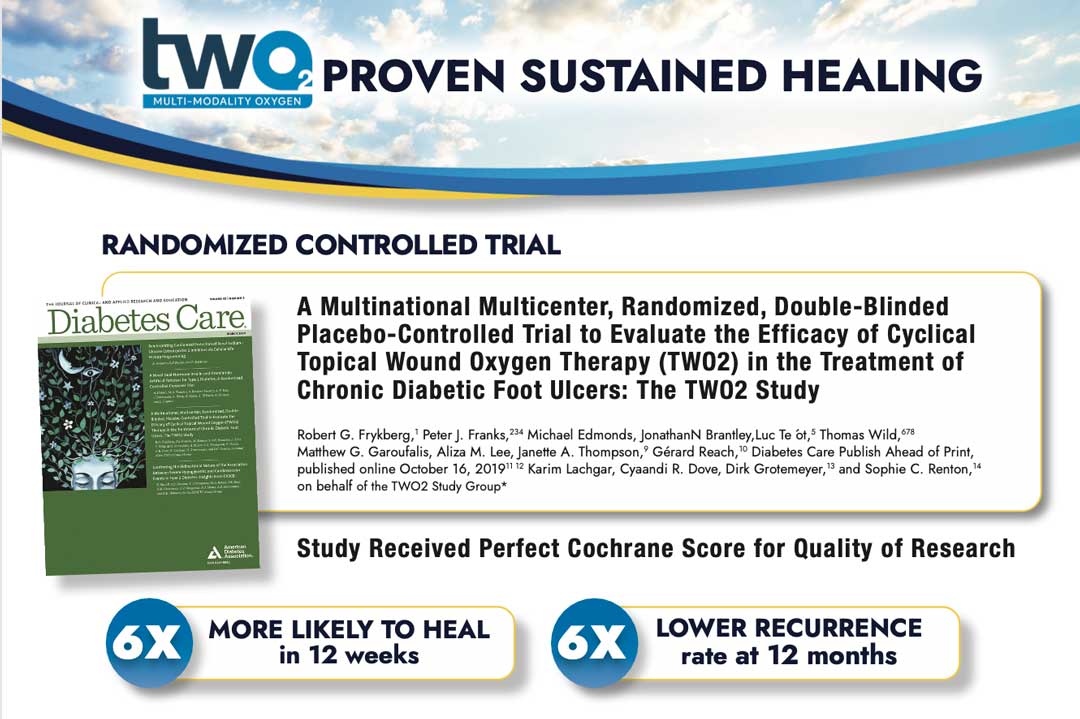RANDOMIZED CONTROLLED TRIAL
A Multinational Multicenter, Randomized, Double-Blinded Placebo-Controlled Trial to Evaluate the Efficacy of Cyclical Topical Wound Oxygen Therapy (TWO2) in the Treatment of Chronic Diabetic Foot Ulcers: The TWO2 Study Robert G. Frykberg,1 Peter J. Franks,234 Michael Edmonds, JonathanN Brantley,Luc Te ́ot,5 Thomas Wild,678 Matthew G. Garoufalis, Aliza M. Lee, Janette A. Thompson,9 Gérard Reach,10 Diabetes Care Publish Ahead of Print, published online October 16, 201911 12 Karim Lachgar, Cyaandi R. Dove, Dirk Grotemeyer,13 and Sophie C. Renton,14 on behalf of the TWO2 Study Group*
RESULTS:
➤TWO2 was shown to be 6 times more likely to heal a DFU at 12 weeks compared to optimal SOC after adjusting for ulcer severity.
➤TWO2 demonstrated more durable healing with a 6 times lower recurrence rate compared to optimal SOC with only 6.7% of Active TWO2 vs 40% of Sham TWO2 ulcers recurring at 12 months.
➤The wound care–focused QOL index improved for patients whose ulcers healed with Active TWO2 in all functional domains, with the greatest improvement seen in the Well-Being component that improved 90-fold.
PRIMARY ENDPOINT OF ULCERS 100% HEALED AT 12 WEEKS:
➤Active TWO2 = 41.7% vs Sham TWO2 = 13.5% (Pearson Ch2 = 7.27, p = 0.007)
➤Odds ratio (OR) of 4.57 (97.8% CI 1.19, 17.57), p = 0.010, after adjustment for University of Texas Classification (UTC) ulcer grade
➤Odds ratio (OR) increased to 6.00 (97.8% CI 1.44, 24.93), p = 0.004
For the patients with larger open ulcers at the end of the 12-week active phase, the mean reduction in ulcer area from baseline was 4.12 cm for Active TWO2 compared with a 1.34 cm increase for the Sham TWO2.
RESEARCH DESIGN:
A state-of-the-art, level 1A evidence, Randomized Controlled Trial (RCT) demonstrating the efficacy of multi-modality cyclical pressure Topical Wound Oxygen (TWO2) therapy in healing and reducing recurrence of Diabetic Foot Ulcers (DFU). A Group Sequential Design was utilized for the study with three predetermined analyses and hard stopping rules at 73, 146 and 220 on completing a 12-week treatment phase (p < 0.022 at each analysis point). All data analysis utilized an Intention-to-treat (ITT) approach. Patients meeting eligibility criteria were enrolled into a 2-week run-in with defined optimal standard-of-care (SOC) Only hard-to-heal ulcers were included in the study, 25% of run-in patients were excluded prior to randomization due to achieving 30% wound area reduction on SOC alone.
CONCLUSION: This sham-controlled, double-blind RCT demonstrates that, at 12 weeks and 12 months, adjunctive cyclical pressurized TWO2 therapy was superior in healing chronic DFUs compared with optimal SOC.
TWO2 therapy was shown to be safe, without complications, and provided more durable healing for those who had wound closure compared to optimal Standard care alone.
Additionally, TWO2 can be easily administered by the patient at home without the expense and difficulties of daily travel to a specialized center and can also be combined with other advanced wound care modalities.
REFERENCES: • National Health Interview Survey by the Centers for Disease Control and Prevention and the U.S. Census Bureau. • Reduced Hospitalizations and Amputations in Patients with Diabetic Foot Ulcers Treated with Cyclical Pressurized Topical Wound Oxygen Therapy: Real-World Outcomes; Jessica Izhakoff Yellin, Julia A. Gaebler, Frank F. Zhou, Timothy Niecko, Olivia Novins, Amelia Ockert, Darcy Krzynowek, Matthew G. Garoufalis, Aliza M. Lee, and Robert G. Frykberg; Advances in Wound Care 2022; http://doi.org/10.1089/wound.2021.0118 • A Multinational, Multicenter, Randomized, Double-Blinded, Placebo-Controlled Trialto Evaluate the Efficacy of Cyclical Topical Wound Oxygen (TWO2) Therapy in the Treatment of Chronic Diabetic Foot Ulcers; The TWO2 Study; Diabetics Care 2020;43:616-624 | https://doi.org/10.2337/dc19-0476.

